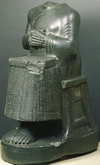Quiz 2 Flashcards
(50 cards)

White Temple and Ziggurat, Uruk (Warka, Iraq), ca. 3500-3000 BC

Stele with law code of Hammurabi, from Susa, Iran, basalt, ca. 1780 BC

Statues of Gudea, including one holding temple plan, from Girsu, Iraq, diorite, ca. 2100 BC

Ziggurat of Ur-Nammu, Ur, Iraq, ca. 2100 BC

Citadel of Sargon II at Dur Sharrukin (Khorsabad, Iraq), ca. 720 BC

Lamassu figures and tribute bearers, gypsum, from Citadel of Sargon II at Dur Sharrukin, ca. 720 BC

Ishtar Gate, Babylon (Iraq), glazed brick, ca. 575 BC
bent-axis approach
– in ancient Mesopotamia, an indirect approach into a temple or cella; generally gods
entered into a temple on the long axis, while humans entered on the short axis and turned 90-degrees to approach the cult statue.
bitumen
an asphalt of Asia Minor used in ancient times as a cement and mortar.
cella
the main room in a temple, housing the cult statue.
lamassu
an Assyrian guardian in the form of a human-headed winged bull.
ziggurat
base of a temple, usually stepped or having a broad ascent winding around it.

Mastaba tomb diagrams

• Entrance hall and colonnade
Imhotep, arch., Funerary complex of King Djoser, Saqqara, Egypt, Dynasty III (Old Kingdom), ca. 2630 BC

• Jubilee Court
Imhotep, arch., Funerary complex of King Djoser, Saqqara, Egypt, Dynasty III (Old Kingdom), ca. 2630 BC

South Palace
Imhotep, arch., Funerary complex of King Djoser, Saqqara, Egypt, Dynasty III (Old Kingdom), ca. 2630 BC

North Palace wall
Imhotep, arch., Funerary complex of King Djoser, Saqqara, Egypt, Dynasty III (Old Kingdom), ca. 2630 BC

Stepped Pyramid
Imhotep, arch., Funerary complex of King Djoser, Saqqara, Egypt, Dynasty III (Old Kingdom), ca. 2630 BC

Bent Pyramid of Sneferu, Dahshur, Egypt, Dynasty IV (Old Kingdom)

Great Sphinx
Pyramid of Khafre (Chefren), Giza, Egypt, Dynasty IV (Old Kingdom), ca. 2530 BC

Valley and mortuary Temple
Pyramid of Khafre (Chefren), Giza, Egypt, Dynasty IV (Old Kingdom), ca. 2530 BC

Great Pyramid of Khufu (Cheops), Giza, Dynasty IV (Old Kingdom), ca. 2550 BC
• Fake tomb
• Grand Gallery
• Queen’s Chamber
• King’s Chamber

Rock-cut tombs at Beni Hasan, Egypt, Dynasty XII (Middle Kingdom), ca. 2000-1900 BC
• Tomb of Amenemhet

Rock-cut tombs at Beni Hasan, Egypt, Dynasty XII (Middle Kingdom), ca. 2000-1900 BC
• Tomb of Amenemhet










